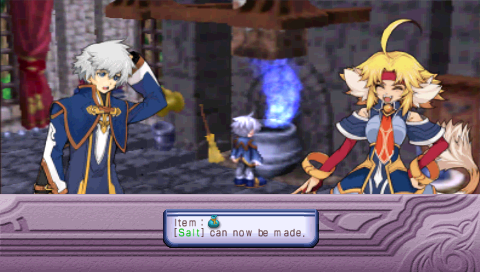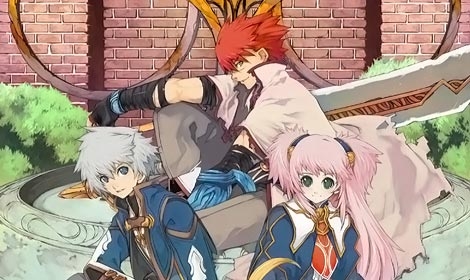Mana Khemia: Student Alliance is a port of a Playstation 2 (PS2) game made by Gust updated for the Playstation Portable (PSP). Gust is famous for developing the Atelier Iris and Ar tonelico series with their games published by NIS America in the United States. Can this port live up to other PSP RPGs and its original PS2 big brother?
Story

Our hero, Vayne Aurelius, finds himself waking up with amnesia in a house unknown to him. Nearby a cat only he can hear introduces himself as Sulpher and reminds Vayne of his name. The two live a quiet life together until a teacher from the alchemy school invites him to attend Al-Revis Academy. The instructor reveals that Vayne's temporary abode once belonged to a famous alchemist. Vayne, wanting to learn more about himself and alchemy, accepts the invitation.
Game Progression

As Vayne, players can sign up for classes from the Student Affairs clerk. Though in the beginning of the game the majority of classes are mandatory, optional classes will open up to players as they progress. In a nutshell, the game has players commit to attending classes which usually entails an assignment. Assignments consist of players having to fight enemies outside of school to obtain items from bosses. Depending on how a player fairs, assignments are given an A to F (excluding D) grade which net different units each. Vayne and his party must earn a certain number of units per term else they could potentially end up in detention. When not on assignments, there are events that help to progress the game's story. Free time allows players a choice of activities from synthesizing items to farming new materials. Though the wealth of options give the illusion of variety, the game still feels pretty linear and repetitive at times.
Gameplay

Battles are turn based and players will be able to see the exact turn order. A Burst Gauge located on the bottom of the screen increases when an attack lands on an enemy. When filled, Burst Mode will increase Vayne and his party's damage output. Every attack has a stun value, and by attacking the same enemy consecutively, players have a chance to stun the enemy, thereby inflicting critical damage. Other traditional RPG elements such as status effects, skills, and elemental strengths and weaknesses are present.
Players also must be aware of a time system within the game. As Vayne ventures out longer outside of school towards the evening, monsters and enemies become more aggressive and stronger. To alleviate this, Vayne is given Icarus Wings, a key item which instantly returns him and his party back to school regardless of location. This will also reset any area previously explored back to morning allowing for continued safe venture.

There is no apparent leveling system in place for the game; instead, players use the Grow Book reminiscent of Final Fantasy X’s sphere grid. Players spend AP points acquired from battle on nodes that provide different stat bonuses such as Health, Attack Points, etc. The quirk here is that in order to unlock the next node (growth elements), players must have had already synthesized a required item listed on the node.
On the occasion that Vayne and his party are defeated in battle, they will typically be brought back to the Infirmary with no penalties unless they are in the middle of an assignment (incurring a lower grade) or a special battle that pertains to the story (game over).
Synthesis

This is an alchemy school after all, and the entire game is centered around it. Players may not always have all the required materials to make a particular item. In this case, Vayne can create a “derived item” by substituting it with another material. As mentioned previously, synthesis is required in order to complete certain assignments, and to progress character growth. This constitutes a basic mechanic and will become increasingly difficult as more complex systems are in place such as Co-op Synthesis and Creative Recipes.
Graphics

Characters are 2D sprites on a semi 3D background. Gust and NIS titles are famous for integrating old disigns with new. There is a background blur effect that happens when a character dialogue pop up which I found to be a bit annoying and upright disorientating to the eyes at times. Other frustrating issues are the occasional stuttering and long load times. It’s a bit problematic when the game chooses to stutter when I simply am jumping around in the game.
Sound
The games theme is repeatedly played over and over and can get a bit annoying. The voice acting like other NIS America games, is quite bearable and actually decent. I am unable to compare it to the original voice actors as this game does not include the original Japanese audio.
Overall
As complicated as this game can sound like at times, the creator’s did spend a good deal of effort providing quick, detailed tutorials and guides within the game. Though the game isn't as fulfilling as other RPGs, it does fit the mold perfectly for a handheld experience. Unfortunately, technical issues and hiccups are the main problems holding this game back.

